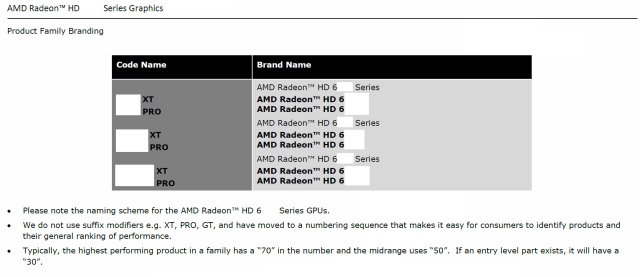Silent_Buddha
Legend
it would be nice, but this slide says otherwise ("50" and "70")...

What's most interesting about that is they go to great lengths to explain xx70, xx50, and xx30. No explanations for an xx90 would imply there is no xx90 in that picture. And there is likely no xx30 in that picture either as the explanation for a "30" is for a hypothetical "If an entry level part exists". As well trying to squeeze in 2 Antilles products above a speculative Cayman 6970 makes for an extremely crowded numbering scheme. So the subtext for that is that there are only xx70 and xx50 cards in that list. [EDIT - Also note how "70" is denoted for the highest performing part. So anything higher than that would be out of the question on the chart]
If we assume that it is talking about Barts, Cayman, and Antilles, that also confirms that each has their own seperate series. so 6x.., 6y.. and 6z... series. In other words due to the way it was created it would be weird if they did, for example.
6800 series
6900 series
6900 series
What would actually be somewhat hilarious is if Barts was 6600 series, Cayman is 6700 series, and Antilles was 6800 series. And Antilles wasn't a dual GPU codename afterall.
But that also leaves open the possibility of what No-X threw into the ring. That dual GPU cards would get something like a 6X50/6X70, where the X denotes a multi-GPU setup.
Anyway, if that's the case, 68xx, 69xx, 6Xxx, I'm still not liking it unless 68xx is a significant performance upgrade over 58xx. If not, then AMD is deliberately breaking their established naming scheme in order to take advantage of non-enthusiast gamers (who don't even benchmark their cards) when they don't have to. As long as 68xx is a significant performance increase over 58xx, I won't have a problem with it. Or if 68xx is the fastest single chip card but still isn't a signficant performance increase (denoting it's the best they could do with a single chip on the same process), I'd be somewhat OK with that.
Regards,
SB



